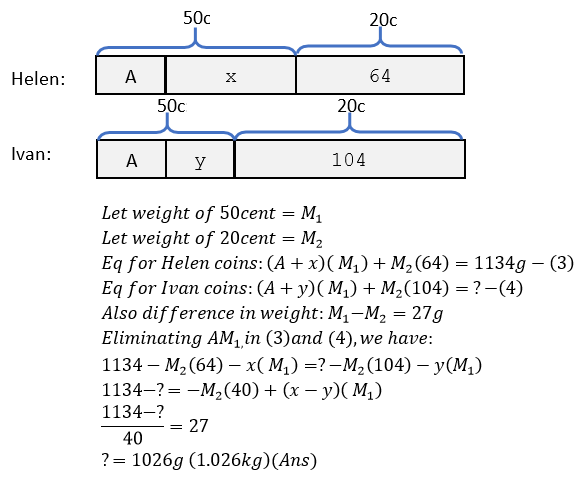Every year’s PSLE math questions is a topic of interest to me to see how challenging these questions can stretch student’s thinking depth. This year’s 2021 PSLE maths exam question is an interesting and fun one to tackle. It is known in the PSLE lingo as a “bonus question”.
Here is the question which you can try to solve yourself, and avoid the spoiler solutions below:
Question:
Helen and Ivan had the same number of coins. Helen had a number of 50-cent coins, and 64 20-cent coins. These coins had a mass of 1.134kg. Ivan had a number of 50-cent coins and 104 20-cent coins.
(a) Who has more money in coins and by how much? (2)
(b) given that each 50-cent coin is 2.7g more heavier than a 20-cent coin, what is the mass of Ivan’s coins in kilograms? (2)
Moreover, these questions stick out from the rest. It’s a mean to differentiate students who really uses their brains out of the box in the exams. These deliberately deceiving questions are designed to filter out those who just memorises textbooks or pile up on 10-year series “tactics”.
I particularly like solving these questions from an Engineer’s perspective. So it could tad be too overkill for a typical 12 year old. But it goes to show there is more than one way to solve a maths puzzle. Depending from where you come from.
Let’s see how to go about solving it today, Engineer style.
(a) Who has more money in coins and by how much? (2)
For the first (a) part, as only a relative difference of value in coins is required. It does not matter how many exact number more 50 cent coins Helen has over Ivan.
Hence, we can safely assume to work within relative equations by deriving the relationship between the number of 50 and 30 cent coins between Helen and Ivan.
 From here, Helen always has 40 more 50 cent coins than Ivan. Hence, it is not wrong to assume Helen as 100 coins and Ivan with 60 too. But it’s does not matter what the exact number is. For simplicity, we shall assume Helen has 40 coins, and Ivan 0 coins. And that gives you an answer of Helen having more money by $12.
From here, Helen always has 40 more 50 cent coins than Ivan. Hence, it is not wrong to assume Helen as 100 coins and Ivan with 60 too. But it’s does not matter what the exact number is. For simplicity, we shall assume Helen has 40 coins, and Ivan 0 coins. And that gives you an answer of Helen having more money by $12.

(b) given that each 50-cent coin is 2.7g more heavier than a 20-cent coin, what is the mass of Ivan’s coins in kilograms? (2)
Engineers, have a tendency to derive Universal equations, where it would allow us to quickly replace variables in the equation to quickly run simulations and optimise the scenario for the best optical solution. Framing the scenario, from part a) we do not know exactly how much 50 cent coins both Helen and Ivan has, just a 40 coin difference, meaning (x-y)=40. Hence, we can put an arbitrary constant ‘A’ in the block diagrams below showing the relationships between the number of coins:

This give you the final answer of Ivan’s coins weighing 1.026kg. Approximately, it takes about 2-4 minutes to logically derive and write down the equations, and about another 2-3 minutes to solve and check the answers. So I can say, it is in the realm of the time to be spent for a 2 mark question. But of course this is no fair comparison to what our primary school students will face given intense exam conditions.
So that’s all folks, though I can probably guess that being a 4 mark question, you do not expect to have this level detail of workings and explanation in place. Maybe a simple 1-2 lines with an answer is all what you need to score full marks in this 2021 PSLE maths exam question.
I put these workings down in detail mainly to educate my readers on the thought process and to appreciate the beauty of such a question that I am delighted to see in the national exams today. It does make you think out of the box.
